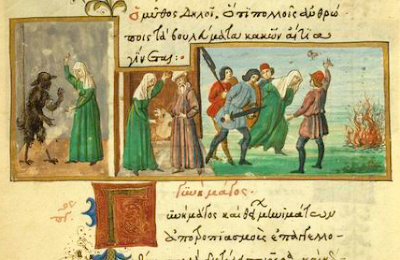READ OUT LOUD. Choose which marked text you prefer to practice with - macrons or accent marks - and read the text out loud until you feel comfortable and confident. Then, try reading the unmarked text at the bottom. It should be easy for you after practicing with the marked texts. :-)
MACRONS. Here is the text with macrons:
Sāga quaedam et mulier dīvīnātrix, āvertere sē deōrum īrās et plācāre infesta nūmina posse, profitēbātur. Quam ream quīdam fēcēre, postulantēs impietātis: causāque iūdicibus probātā, cum ad supplicium illa damnāta abdūcerētur, dē turbā quīdam irrīdēns: Heus tū, inquit, quae pollicēbāre aliīs dīvīnae īrae prōcūrātiōnem, nōn potuistī hūmānam sententiam mītigāre?
ACCENT MARKS. Here is the text with ecclesiastical accents, plus some color-coding for the words of three or more syllables (blue: penultimate stress; red: antepenultimate stress):
Saga quaedam et múlier divinátrix, avértere se deórum iras et placáre infésta númina posse, profitebátur. Quam ream quidam fecére, postulántes impietátis: causáque iudícibus probáta, cum ad supplícium illa damnáta abducerétur, de turba quidam irrídens: Heus tu, inquit, quae pollicebáre áliis divínae irae procuratiónem, non potuísti humánam senténtiam mitigáre?
UNMARKED TEXT. Here is the unmarked text - after practicing with the marked text that you prefer, you should not have any trouble with the unmarked text:
Saga quaedam et mulier divinatrix,
avertere se deorum iras
et placare infesta numina posse,
profitebatur.
Quam ream
quidam fecere,
postulantes impietatis:
causaque iudicibus probata,
cum
ad supplicium
illa damnata abduceretur,
de turba quidam irridens:
Heus tu, inquit,
quae pollicebare aliis
divinae irae procurationem,
non potuisti
humanam sententiam mitigare?
Here is an illustration from the Medici Aesop, which is online at the New York Public Library website.








